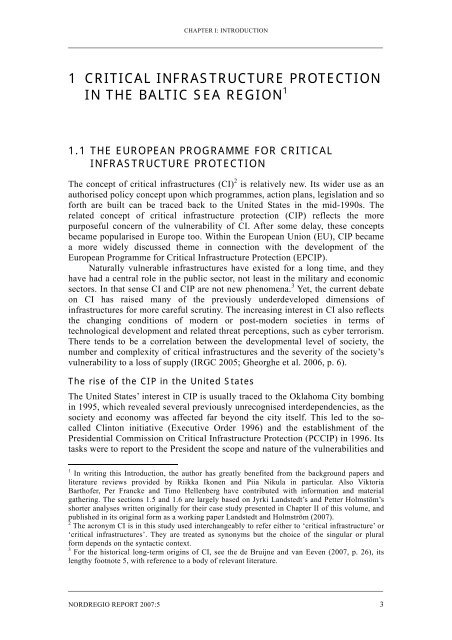Towards a Baltic Sea Region Strategy in Critical ... - Helsinki.fi
Towards a Baltic Sea Region Strategy in Critical ... - Helsinki.fi
Towards a Baltic Sea Region Strategy in Critical ... - Helsinki.fi
You also want an ePaper? Increase the reach of your titles
YUMPU automatically turns print PDFs into web optimized ePapers that Google loves.
CHAPTER I: INTRODUCTION<br />
1 CRITICAL INFRASTRUCTURE PROTECTION<br />
IN THE BALTIC SEA REGION 1<br />
1.1 THE EUROPEAN PROGRAMME FOR CRITICAL<br />
INFRASTRUCTURE PROTECTION<br />
The concept of critical <strong>in</strong>frastructures (CI) 2 is relatively new. Its wider use as an<br />
authorised policy concept upon which programmes, action plans, legislation and so<br />
forth are built can be traced back to the United States <strong>in</strong> the mid-1990s. The<br />
related concept of critical <strong>in</strong>frastructure protection (CIP) reflects the more<br />
purposeful concern of the vulnerability of CI. After some delay, these concepts<br />
became popularised <strong>in</strong> Europe too. With<strong>in</strong> the European Union (EU), CIP became<br />
a more widely discussed theme <strong>in</strong> connection with the development of the<br />
European Programme for <strong>Critical</strong> Infrastructure Protection (EPCIP).<br />
Naturally vulnerable <strong>in</strong>frastructures have existed for a long time, and they<br />
have had a central role <strong>in</strong> the public sector, not least <strong>in</strong> the military and economic<br />
sectors. In that sense CI and CIP are not new phenomena. 3 Yet, the current debate<br />
on CI has raised many of the previously underdeveloped dimensions of<br />
<strong>in</strong>frastructures for more careful scrut<strong>in</strong>y. The <strong>in</strong>creas<strong>in</strong>g <strong>in</strong>terest <strong>in</strong> CI also reflects<br />
the chang<strong>in</strong>g conditions of modern or post-modern societies <strong>in</strong> terms of<br />
technological development and related threat perceptions, such as cyber terrorism.<br />
There tends to be a correlation between the developmental level of society, the<br />
number and complexity of critical <strong>in</strong>frastructures and the severity of the society’s<br />
vulnerability to a loss of supply (IRGC 2005; Gheorghe et al. 2006, p. 6).<br />
The rise of the CIP <strong>in</strong> the United States<br />
The United States’ <strong>in</strong>terest <strong>in</strong> CIP is usually traced to the Oklahoma City bomb<strong>in</strong>g<br />
<strong>in</strong> 1995, which revealed several previously unrecognised <strong>in</strong>terdependencies, as the<br />
society and economy was affected far beyond the city itself. This led to the socalled<br />
Cl<strong>in</strong>ton <strong>in</strong>itiative (Executive Order 1996) and the establishment of the<br />
Presidential Commission on <strong>Critical</strong> Infrastructure Protection (PCCIP) <strong>in</strong> 1996. Its<br />
tasks were to report to the President the scope and nature of the vulnerabilities and<br />
1 In writ<strong>in</strong>g this Introduction, the author has greatly bene<strong>fi</strong>ted from the background papers and<br />
literature reviews provided by Riikka Ikonen and Piia Nikula <strong>in</strong> particular. Also Viktoria<br />
Barthofer, Per Francke and Timo Hellenberg have contributed with <strong>in</strong>formation and material<br />
gather<strong>in</strong>g. The sections 1.5 and 1.6 are largely based on Jyrki Landstedt’s and Petter Holmstöm’s<br />
shorter analyses written orig<strong>in</strong>ally for their case study presented <strong>in</strong> Chapter II of this volume, and<br />
published <strong>in</strong> its orig<strong>in</strong>al form as a work<strong>in</strong>g paper Landstedt and Holmström (2007).<br />
2 The acronym CI is <strong>in</strong> this study used <strong>in</strong>terchangeably to refer either to ‘critical <strong>in</strong>frastructure’ or<br />
‘critical <strong>in</strong>frastructures’. They are treated as synonyms but the choice of the s<strong>in</strong>gular or plural<br />
form depends on the syntactic context.<br />
3 For the historical long-term orig<strong>in</strong>s of CI, see the de Bruijne and van Eeven (2007, p. 26), its<br />
lengthy footnote 5, with reference to a body of relevant literature.<br />
NORDREGIO REPORT 2007:5 3

















